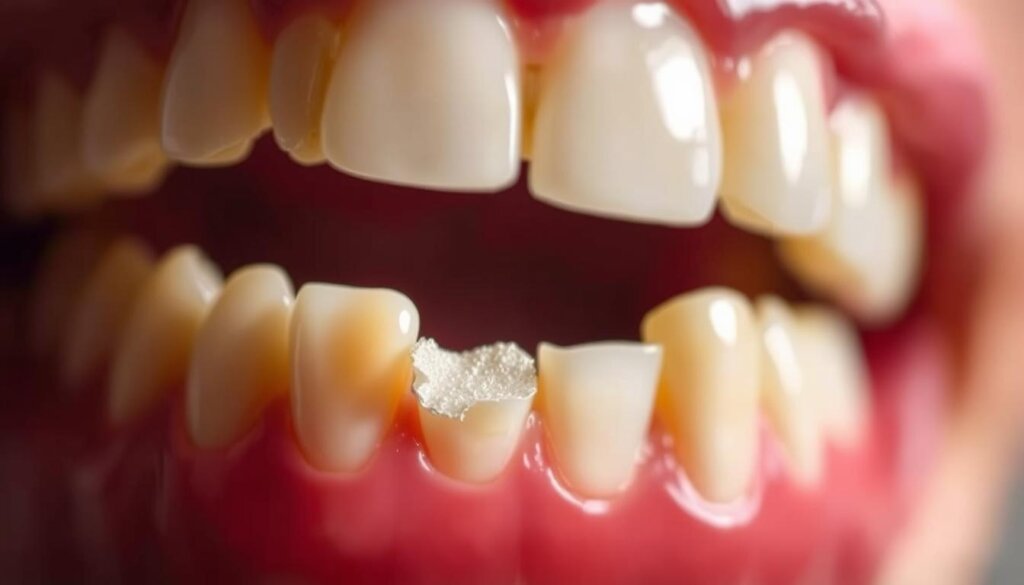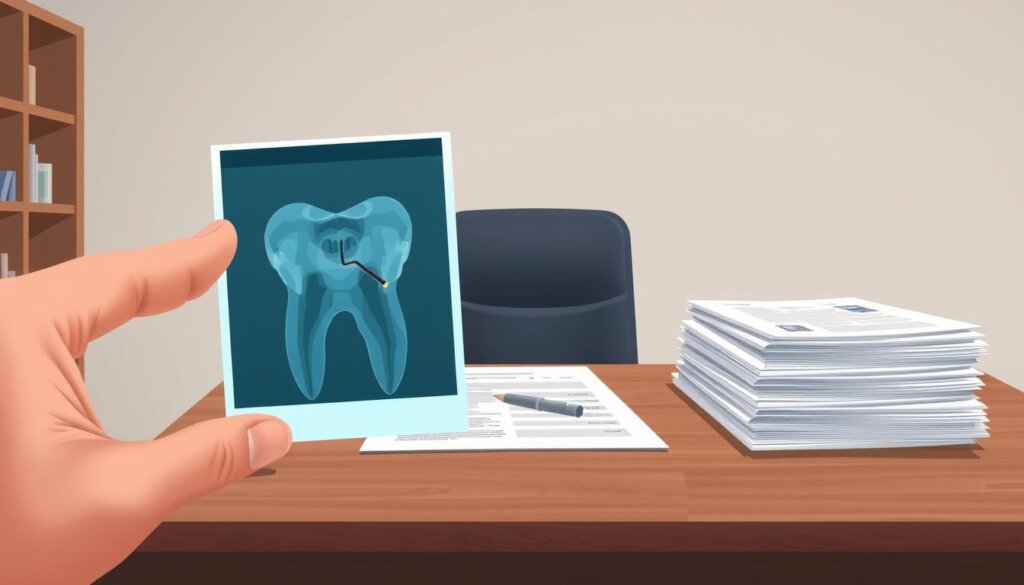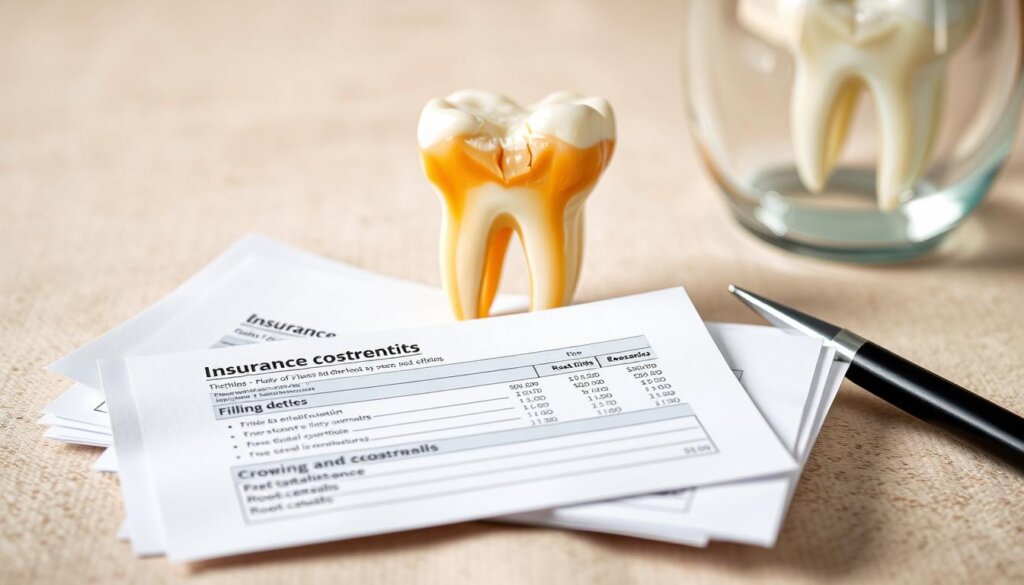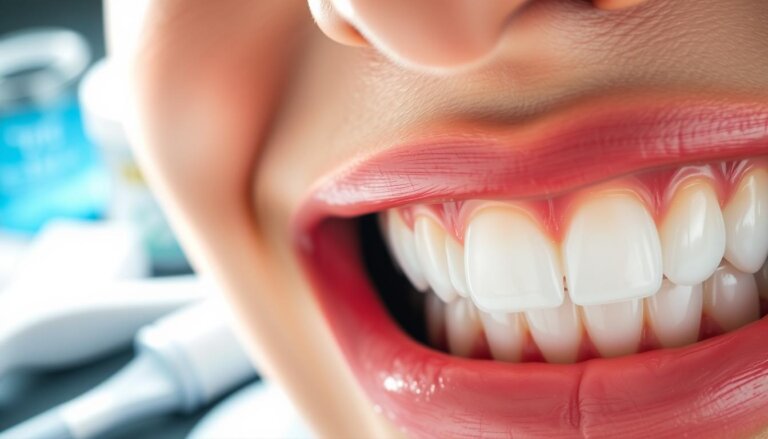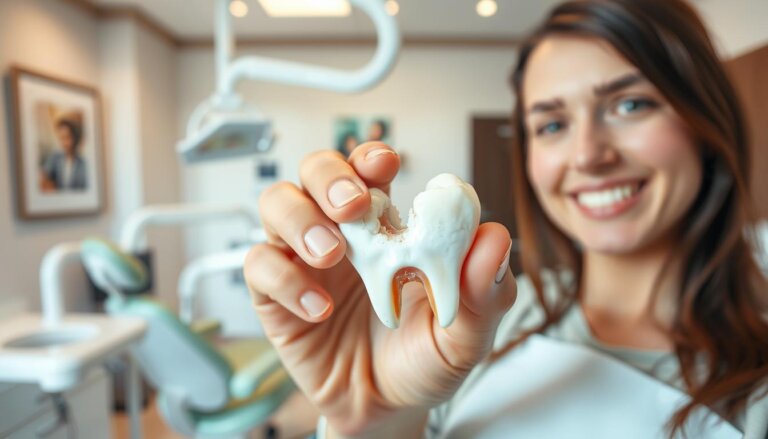Will My Dental Insurance Cover Fixing a Broken Tooth?
About 15% of adults in the United States have chipped or fractured teeth. This can make them wonder: Will my dental insurance cover fixing a broken tooth?
Insurance plans vary, but most check if the tooth break is medically necessary. Coverage often depends on your policy’s terms, deductibles, and how much you can spend each year. It’s important to understand your policy before getting treatment.
Key Takeaways
- Many Americans face chipped or broken teeth each year.
- Policies differ in how they categorize and cover such incidents.
- Reviewing your plan’s terms and annual maximums is key.
- Dentists may file claims based on medical necessity.
- Staying informed helps you budget and plan for treatment.
- Contacting your insurance provider ahead of time can prevent surprises.
Understanding Dental Insurance Coverage
Dental insurance is key when unexpected dental issues arise. Many plans focus on preventive care. But, some also cover more, like broken tooth repairs if they’re medically needed.
What is Dental Insurance?
Dental insurance helps manage dental costs. It covers things like check-ups, cleanings, and repairs. This encourages people to take care of small problems early on.
Key Terms to Know
Understanding insurance terms is important. It helps make informed choices and predict costs. Key terms include:
- Annual Maximum: The most your plan pays each year.
- Deductible: What you pay first before insurance kicks in.
- Coinsurance: A split cost between you and your insurer.
Types of Plans Available
In the U.S., you’ll find HMO, PPO, and indemnity plans. HMOs limit you to certain dentists. PPOs offer more choices but cost more. Indemnity plans let you see any dentist but might cost more out of pocket.
Common Types of Dental Procedures
Healthy teeth need various treatments to keep them strong and looking good. Many dentists suggest methods that strengthen enamel and prevent more damage. These treatments help keep your teeth healthy for a long time. Sometimes, dental insurance for broken tooth repair covers these options. For more on modern bonding, check out this guide.
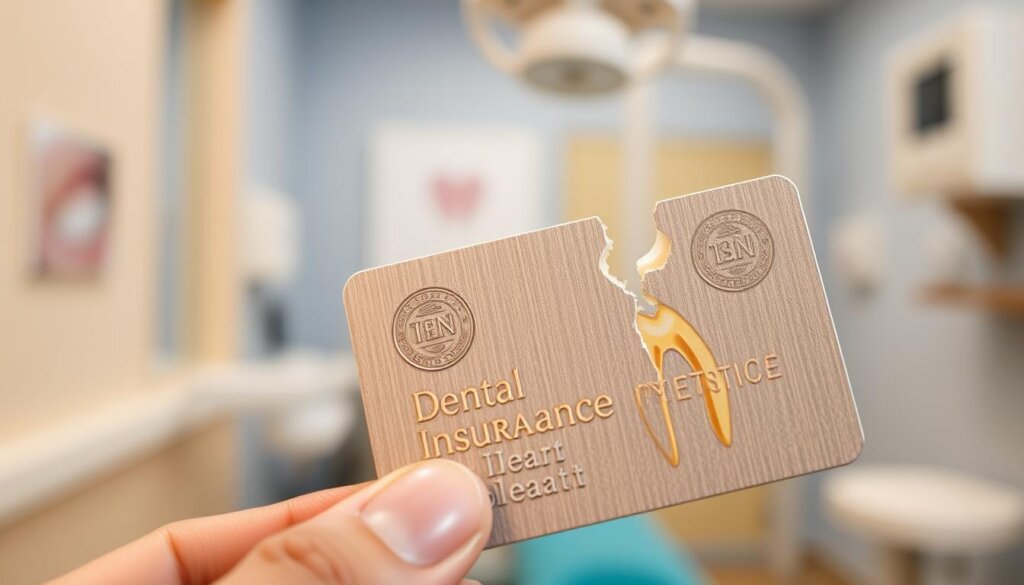
Restorative Procedures Explained
These treatments aim to keep your natural tooth while fixing breaks or decay. Common methods include:
- Fillings to seal voids caused by cavities
- Crowns to cover weakened structures
- Inlays or onlays for partial surface replacements
Dentists choose materials that are strong and safe for your body. This ensures your comfort and the treatment’s long-lasting effect.
Cosmetic vs. Medical Necessity
Big chips or cracks can make chewing hard. If your tooth needs a fix for function, you might get dental insurance for broken tooth repair help. But, if you just want to improve looks, like with veneers, insurance might not cover it. Knowing this helps figure out what’s covered and what you might pay for yourself.
Coverage for Broken Teeth
Many insurance plans cover dental injuries that affect function and health. Delta Dental and Cigna have different rules, but most agree on quick action for tooth damage.
Why Dental Insurance May Cover Treatments
Insurance supports treatments that stop infections or decay. Insurers might ask for proof of need, like scans and doctor’s notes. Quick reporting of accidents can speed up getting insurance for broken tooth treatments.
- Maintain detailed records of the incident
- Collect diagnostic scans and practitioner notes
- Confirm coverage categories with the insurer
| Procedure | Approximate Coverage |
|---|---|
| Bonding | Partial to full, depending on plan details |
| Crowns | Often covered when structural integrity is compromised |
| Implants | Typically requires prior approval and proof of necessity |
Common Procedures for Broken Teeth
Fixes include fillings, root canals, or implants. Dentists choose the best option for each case. Before getting repairs, it’s wise to check your insurance policy.
Factors Affecting Coverage Decisions
Coverage often depends on what a plan considers necessary care. To succeed with a dental insurance broken tooth claim, knowing typical limits and deadlines is key. Some plans have specific caps or exclude treatments if they don’t fit certain guidelines.
Policy Limitations
Insurers can set maximums or deny certain procedures. It’s important to review your policy carefully. Each plan is different in how it handles ongoing treatments. They might have strict cost limits or only cover basic services.
Waiting Periods
Some policies require a waiting time before covering major dental work. This waiting period can stop immediate reimbursement if a claim is filed too early. Patients with urgent needs might face extra costs until the waiting period ends.
Type of Dental Plan
The type of dental plan you have affects where and how treatments are approved. Plans can be HMO, PPO, or indemnity, each with its own rules. Knowing these differences helps you better manage your expenses.
Types of Dental Plans and Their Coverage
Different dental plans offer unique benefits. They support various treatment approaches. Choosing the right plan can help with quick claims processing and cover unexpected costs.
Plan type affects your network, how you get reimbursed, and coverage limits. Knowing these differences helps manage costs and protect your teeth. Which plan fits your needs best?
HMO vs. PPO Plans
HMO plans have a smaller network, making some costs easier but limiting choices. PPO plans let you see more doctors, but they might cost more. Both cover emergencies, but how you get paid back depends on the plan.
Indemnity Plans
Indemnity plans pay you back directly. You pay for services first and then claim it back. This option offers flexibility but requires keeping good records. Good records help process claims quickly and efficiently.
How to Verify Your Coverage
Checking your insurance before any dental work is key. It helps avoid surprises and ensures clear communication. This approach also reduces the chance of claim denials and focuses on patient care.
Talking about dental coverage for a broken tooth helps make quick decisions. It also shows how much you might get back. Taking these steps can save time and money.
Contact Your Insurance Provider
Start by calling or using an online portal to talk to a representative. Have your policy number, personal info, and questions about dental coverage ready. This way, you get the right support and know any network limits.
Review Your Policy Document
Your policy manual explains what’s covered and what’s not. It lists deductibles, how much you’ll get back, and when. Keeping track of these details helps you make informed choices and get care efficiently.
Costs Associated with Repairing a Broken Tooth
The cost to fix a broken tooth depends on how bad it is. Some small breaks might just need a filling. But bigger breaks might need a crown, veneers, or even an implant.
Insurance can help pay for these treatments. But how much they cover depends on your deductible and how much you can use each year.
If you use up your insurance limit or need a big procedure, you might have to pay more. You might also have to pay for tests or X-rays. Planning ahead can help you save money and reduce stress.
- Exams and X-rays can lead to initial costs
- Some policies restrict certain dental materials
- Waiting periods may delay coverage
| Procedure | Approximate Cost (USD) | Insurance Coverage |
|---|---|---|
| Dental Bonding | 100 – 400 | Partial |
| Crown | 500 – 1,500 | Varies by Plan |
| Implant | 1,500 – 3,000 | Major Service |
Importance of Documenting Your Dental Issue
Getting evidence right away is key for dental insurance claims. It shows the damage and why you need to fix it fast. Clear records help providers understand your case.
Photographs and Detailed Descriptions
Good photos show where and how bad the tooth is damaged. Notes from dentists add context to these pictures. They prove you need care quickly and it’s medically necessary.
Dental Records and Previous Treatments
Looking at your dental history helps find why the tooth broke. It includes past work like fillings or implants. This history gives a full picture of your teeth’s health.
Alternative Payment Options
Big dental bills can really hurt your wallet when insurance doesn’t cover enough. Many people look for ways to ease the financial burden without sacrificing their dental health. A good solution is to explore financing options that make big costs smaller and easier to handle.
Payment Plans Offered by Dentists
Dentists often work with lenders or have their own financing plans. These plans split the cost of treatments like root canals or implants into smaller monthly payments. This makes it easier for people who don’t want to pay everything at once.
- Extended term options for complex procedures
- Potentially low-interest promotional deals
- Flexible repayment schedules
Dental Care Financing Programs
Companies like CareCredit team up with dental offices, giving patients time to pay for important treatments. These programs often offer special rates that lower interest. It’s smart to look at different options to find the best deal and avoid hidden fees.
| Plan Type | Key Features | Considerations |
|---|---|---|
| In-House Payment Plan | Direct agreement with your dentist | Check interest and late fees |
| Third-Party Financing | Promotional rates and flexible terms | Review credit checks and associated costs |
The Role of Dental Networks
Many insurers use a structured dental network to manage expenses and maintain consistent care. These collaborations set specific fees for treatments, making care more accessible. When you face unexpected tooth damage, knowing if a dentist is in-network can mean predictable costs and easier approval.
Confirming if a dentist is in-network before your visit can help avoid billing surprises. It’s a smart way to plan for broken tooth repairs without sacrificing quality or advanced techniques.
In-Network vs. Out-of-Network Providers
Some providers have contracts with certain insurers, which means they charge set fees. This can help lower what you pay out of pocket. Others don’t have these contracts, so they charge based on their own prices. This difference is key when you need restorative treatments.
Benefits of Staying Within Your Network
In-network providers make filing claims easier and paperwork less. They often have direct billing systems that speed up the process. This way, you can get the care you need without breaking the bank.
| Provider Category | Typical Costs | Coverage Benefits |
|---|---|---|
| In-Network | Lower negotiated rates | Streamlined claims and predictable expenses |
| Out-of-Network | Higher and variable fees | Less insurer support and increased patient responsibility |
Situations That Affect Coverage
Unplanned events and past dental work can impact insurance decisions. Providers like Delta Dental or Blue Cross have clear rules for sudden injuries or long-standing issues. Sometimes, medical benefits can overlap if urgent care is needed for a broken tooth.
Emergencies and Accidents
Unexpected tooth breakage can happen from sports accidents, car crashes, or slipping on wet floors. These incidents often require detailed medical proof. Insurers might ask for documents to show the extent of the damage.
Coverage can change if the injury is seen as trauma. This might lead to higher reimbursement rates.
Impact of Prior Dental History
Insurers might look at chronic tooth damage or a history of frequent repairs. They might ask for more proof that the new incident isn’t related to old problems. Detailed dental records can help show the break’s nature, improving coverage chances.
Choosing the Right Dentist for Treatment
Finding the right dentist is key. Look for those with the right credentials and experience. Dentists in groups like the American Dental Association are a good start. They show they meet high standards.
Advanced training in crowns or implants is important. It shows they can handle complex cases. This is vital for fixing broken teeth or doing big restorations.
Factors to Consider
Here are some things to think about:
- Professional licenses and board certifications
- Use of modern technologies for improved procedures
- Clear communication about financial policies
Questions to Ask Before Treatment
Being open about treatment is important. Check if the dentist is in your network. This helps with cost planning and insurance.
Ask for a detailed treatment plan. Also, find out about financing options. This way, you avoid surprises and feel confident in your choice.
Steps to Take If Your Claim is Denied
When insurers doubt the need for treatments or spot a coding error, you might face a claim denial. Having a plan can help you deal with this and keep your coverage.
Start by collecting all important documents, like X-rays and notes from your dentist. These records help prove that the treatment is necessary and follows the right standards.
Appeals Process Explained
To appeal a denial, you need a clear strategy. A written request and professional support often lead to a second look. Here’s what to do:
- Check the explanation of benefits to find out why your claim was denied.
- Send in the claim again with the right codes and all the evidence you have.
- Ask your dentist for help on how to document everything properly.
Importance of a Second Opinion
Getting a second opinion from another dentist can really help. It shows that your treatment is needed. Insurers often listen to experts, so this can change their mind.
Final Thoughts on Coverage for Broken Teeth
Choosing dental insurance can be tricky. Each plan in the U.S. has its own rules. Knowing these helps avoid surprise bills when a tooth breaks.
Understanding Your Insurance Is Key
Looking at your dental plan’s benefits is important. It shows how much you can spend each year. It also tells you if fixing a broken tooth is covered.
Talking to a dental insurance expert can help. They can explain what your plan covers. This makes planning your dental care easier.
Importance of Regular Dental Check-Ups
Regular dental visits can catch small problems early. This means you might avoid costly fixes later. It also keeps your teeth healthy for longer.
Going to the dentist regularly helps with insurance claims too. It makes sure you get the coverage you need for broken teeth.

